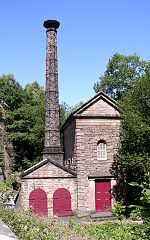High Peak Junction
Canals in DerbyshireClosed railway lines in the East MidlandsEarly British railway companiesMuseums in DerbyshirePeak District ... and 6 more
Rail transport in DerbyshireRailway museums in EnglandSites of Special Scientific Interest in DerbyshireTourist attractions of the Peak DistrictTransport in DerbyshireUse British English from February 2018

High Peak Junction, near Cromford, Derbyshire, England, is the name now used to describe the site where the former Cromford and High Peak Railway (C&HPR), whose workshops were located here, meets the Cromford Canal. It lies within Derwent Valley Mills World Heritage Site, designated in 2001, and today marks the southern end of the High Peak Trail, a 17 miles (27 km) trail for walkers, cyclists and horse riders. The Derwent Valley Heritage Way also passes this point, and popular walks lead from here along the towpath in both directions.
Excerpt from the Wikipedia article High Peak Junction (License: CC BY-SA 3.0, Authors, Images).High Peak Junction
Derby Road, Derbyshire Dales
Geographical coordinates (GPS) Address External links Nearby Places Show on map
Geographical coordinates (GPS)
| Latitude | Longitude |
|---|---|
| N 53.1002 ° | E -1.5334 ° |
Address
High Peak Junction
Derby Road
DE4 5HN Derbyshire Dales
England, United Kingdom
Open on Google Maps










